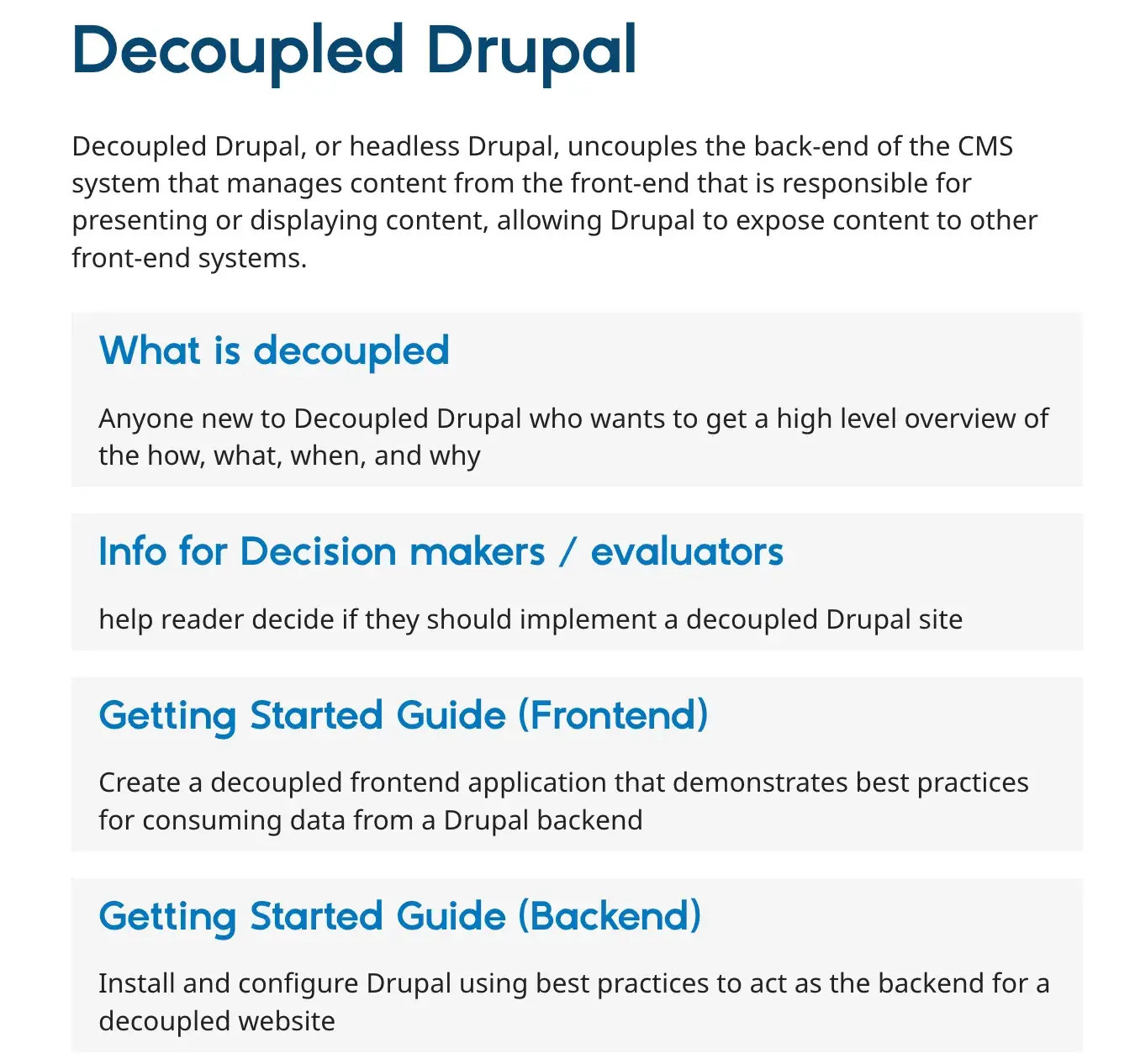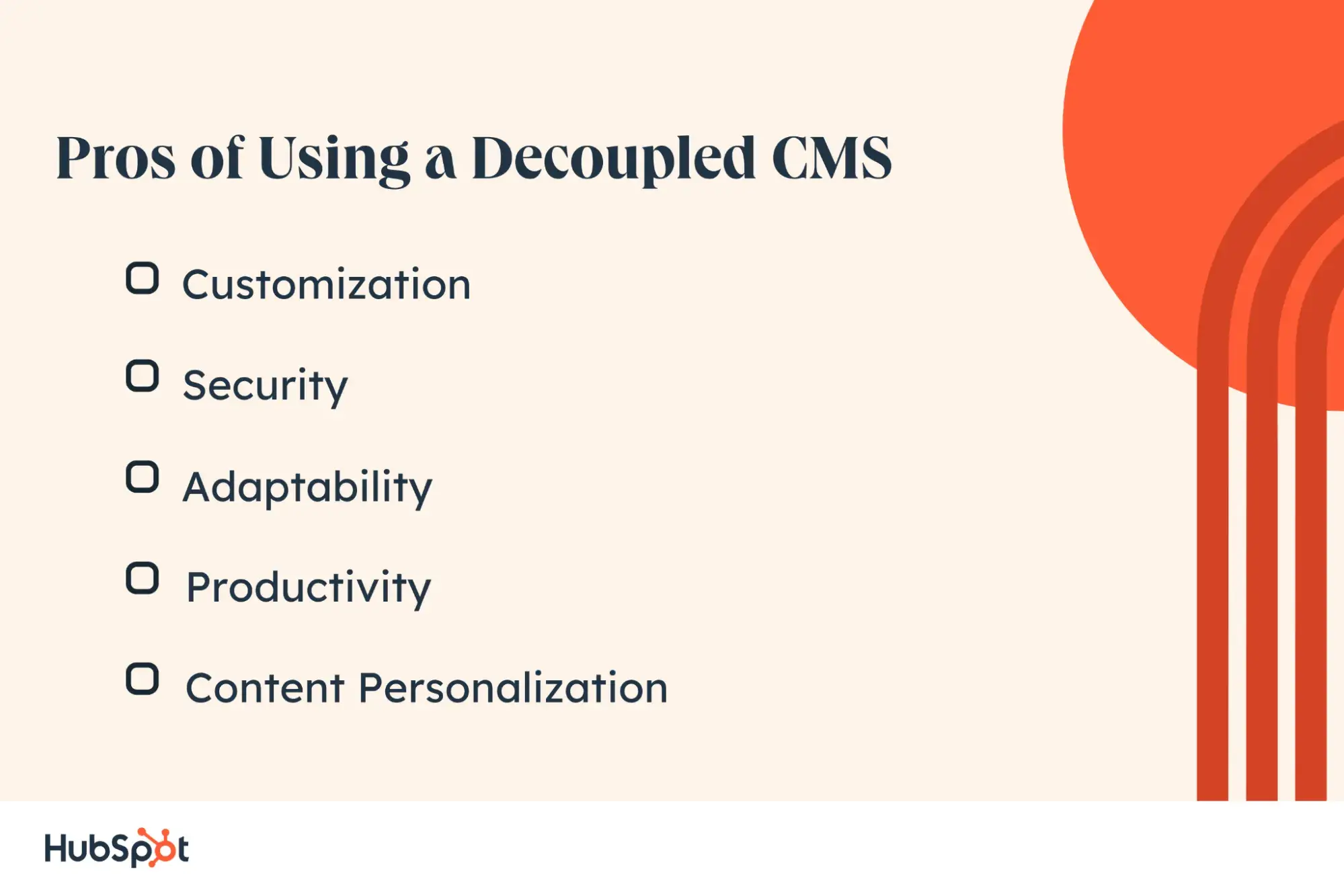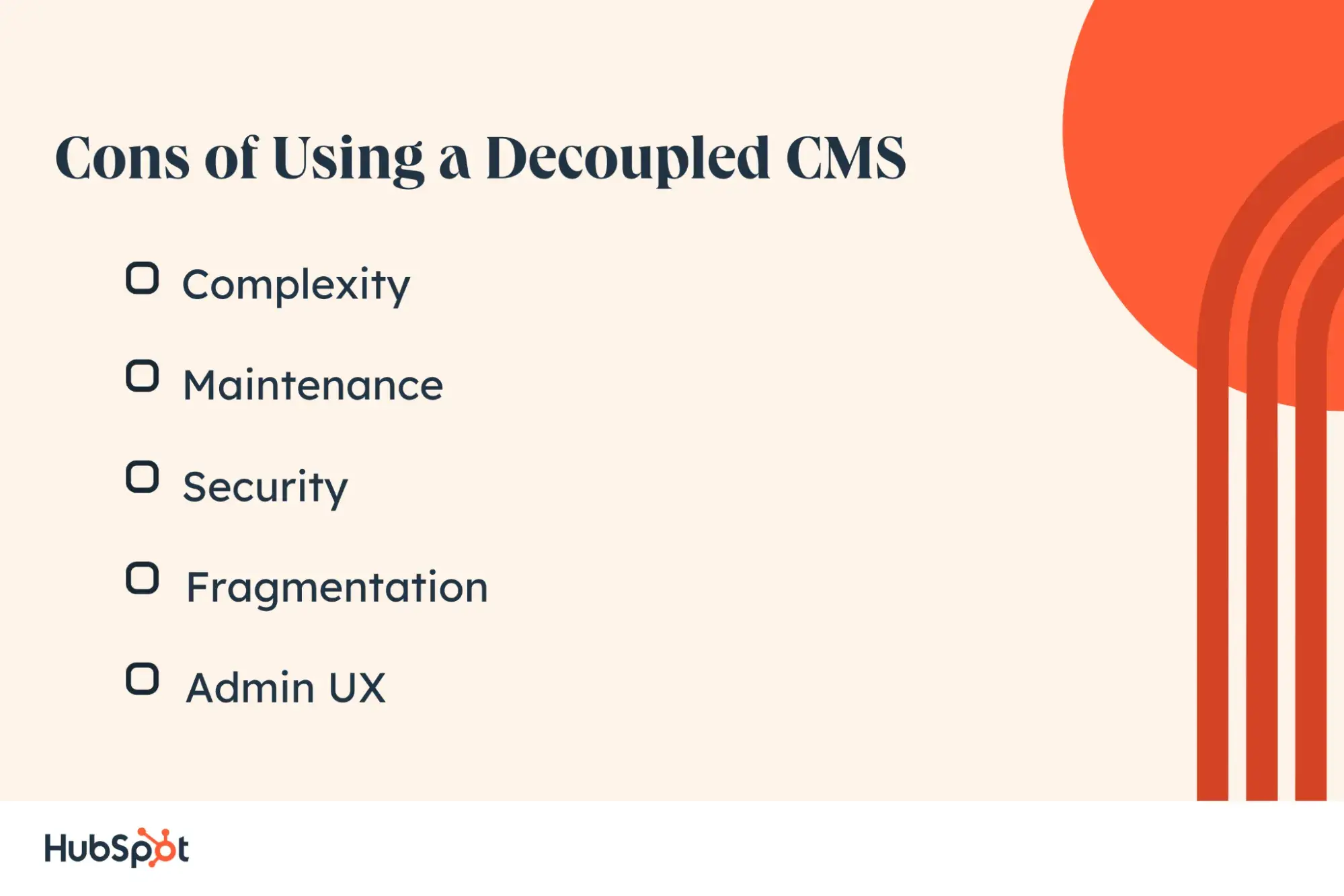In this article, we’ll be diving into one of the most powerful CMS structures on the market: the decoupled CMS. I’ll define how the tool works and then take a look at how it stacks up to similar alternatives. Finally, I’ll guide you through some questions to determine whether or not the decoupled CMS is the right tool for your organization.
Table of Contents
- What Is a Decoupled CMS?
- Pros of Using a Decoupled CMS
- Cons of Using a Decoupled CMS
- Should You Use a Decoupled CMS?
What Is a Decoupled CMS?
Before I can define a decoupled CMS, you need to understand the two halves that make up a content management system in the first place: the front end and the back end.
The front end of a content management system is the part of the CMS that faces the readers. When you upload a piece of content and hit “Publish,” the rendering your readers encounter happens on the front end.
The back end, on the other hand, is the behind-the-scenes aspects of your CMS. The back end holds your content database, user roles, workflows, and the CMS functionalities you use to control, edit, deliver, and store content. As a writer (and not a designer), I’ve only interacted with the back end of a CMS.
If you’ve used HubSpot or the standard Wordpress interface, you’ve taken advantage of a traditional or coupled CMS, where the front end and back end are totally connected — content is stored and managed completely in the CMS without having to rely on an API. But in a decoupled CMS, the front end and back end are separated, only bridged through the use of APIs. Drupal, for example, has a decoupled option, which I show below.

When the connection between the front end and back end of your CMS are solely through APIs, you wind up with a world of possibilities for what your content looks like and where your content goes.
What is a Decoupled vs. Headless CMS?
Decoupled and headless CMSs are often used interchangeably, but they are a little bit different — and here’s a hint. The front end of a CMS can also be called the head.
With that context, you can probably guess what a headless CMS is: a content management system that doesn’t have a front end at all.
In a decoupled CMS, APIs can connect content storage and management straight to a default front end. But in a headless CMS, there’s no default or template. While both types of CMSs can take content to multiple channels through APIs, there are no references to front-end renderings in a headless CMS.
Here are the three key differences:
- Content previewing. In a decoupled CMS, back-end users can preview and edit content that appears on the front end. Headless CMSs are much less likely to include previewing capabilities without a custom API or third-party integration.
- Built-in features. Decoupled CMSs are generally feature-rich, with a back end resembling traditional CMSs. Headless CMSs are more streamlined, often lacking common CMS features like workflow management. However, some providers incorporate more customizable features in a headless CMS.
- Templates. Decoupled CMSs often rely on templates for front-end renderings, while headless CMSs are completely template-agnostic, providing content data without formatting.
Theodore Kelechukwu Onyejiaku, the technical content manager at Strapi, explained to me the key difference in the debate between headless versus decoupled CMS.
“The headless architecture gives developers total freedom to define the front end separately. At the same time, the decoupled system still offers some guidance on how content might be displayed.”
Pros of Using a Decoupled CMS
Onyejiaku made it clear to me that, in his expert opinion, the decoupled CMS is “the best of both worlds.” From flexibility to personalization, let’s take a look at some of the major advantages of a decoupled CMS.

Customization
The main advantage of a decoupled CMS over a traditional CMS is customization. By separating the back end from the front end, but keeping a default, you gain customizability without completely compromising simplicity. When you’re ready to leave the default, you can use the flexibility of a decoupled CMS in a few different ways:
- Channels. Decoupled CMSs support omnichannel delivery. By separating the front end and back end, you gain the freedom to send your content to any number of channels without having to alter the original content. Whether you’re sending to your default website or a custom app, you have complete channel freedom — and content updates still draw from the single source of truth across channels.
- Devices. Because you can specifically design your front ends for any channel, you can also alter them per device without a hassle. Resize images for mobile, smartwatches, and more, so that your content always looks like a perfect fit.
- Languages. Multilingual support is easier when you’re using a decoupled CMS. While in the back end, you’ll need to store multiple language versions of your piece of content, the front-end customization enables you to present content in a culturally optimal way. Text direction, localized formatting (like dates and currency), and even SEO practices can be customized when using a decoupled CMS.
Security
Separating the front end and back end of your CMS comes with some security advantages. APIs that manage your content delivery can actually serve as a buffer between end users and your company’s content data. You can also use content delivery networks on your front end to protect the data stored in the back end, minimizing attacks and keeping your data safe and sound.
Adaptability
API-driven structures are far more adaptable and replaceable than alternatives, allowing improvements in your platforms and integrations without requiring a full overhaul of your CMS. You can adopt new front-end technologies or massively alter front-end designs without changing your single source of truth: the back end. Plus, APIs make it easy for you to connect your CMS to other tools, so if you alter your CRM or analytics stack, you can assume your CMS will click in easily.
Productivity
When you separate the front end from the back end, you eliminate bottlenecks — because the front-end teams (designers and developers) don’t need to coordinate with the back-end teams (writers, editors, and administrators) to do their jobs. UI/UX, branding, and content can all be updated with minimal interdepartmental coordination.
Content Personalization
Content that’s created in the back end of your decoupled CMS isn’t just automatically uploaded to your site — it’s delivered through APIs as structured data. As a result, it can be dynamically adjusted and personalized based on visitor demographics. This enables a wide variety of personalization techniques, landing the most resonant content in front of each member of your audience.
Cons of Using a Decoupled CMS
A decoupled CMS sounds like a flawless way to reach your audience — but it’s not without its own obstacles. I’ll share some of the drawbacks.

Complexity
The major advantage of using a traditional CMS is that it’s simple to operate. While the complexity of a decoupled CMS can be an advantage in that it has a broad variety of applications, it can also be a drawback. Because of the tool’s breadth, set-up can take a lot longer. Internal training is also a must, because it won’t feel intuitive to non-technical users or a content team that has just worked with traditional CMSs.
Maintenance
Because a decoupled CMS has two main components, instead of a single, unified front- and back end like the traditional CMS, maintenance can be more extensive. Both the front end and the back end require monitoring, troubleshooting, and upkeep, which can sometimes be more technical and time-consuming than a traditional CMS.
Security
While APIs generally ensure more security, they also pose some unique security risks. When not secured properly, transmitted or accessed data can become DDoS targets or victims of data interception. These risks can have serious consequences for your data’s integrity.
Pro tip: Security measures like user authentication, authorization, rate limiting, and HTTPs encryption are important ways to protect against API security issues.
Fragmentation
In a decoupled CMS, the front end isn’t automated. When developers or designers choose to depart from the default template, there’s more potential for variation and, if done poorly, fragmentation. Companies using a decoupled CMS need to make sure their brand guidelines are clear so that channels are unified in their design and messaging.
Admin UX
Many of the team members working in the back end of any CMS are non-technical: marketers, editors, and writers like me. Decoupled CMSs don’t have a reputation for being extremely user-friendly for back-end workers with little technical knowledge and, when decoupled CMSs don’t offer the preview function, these team members may feel like something is missing from their CMS.
Should You Use a Decoupled CMS?
When you’re assessing whether or not the decoupled CMS is the right tool for your organization, I think it’s most important to determine whether or not you need a departure from the traditional CMS. And, if you do need a departure, do you need an entirely headless one — or will the “best of both worlds” check the box?
Here are some variables I think you should assess as you make your decision.
Feature Priorities
Is it important that you have front-end control over multiple channels, or are you looking to send content to exclusively one location? If you only have one content destination, a traditional CMS will likely work just fine.
If you have multiple channels, how important is customization to you? If you use a templated design at times but want a high level of customization, a decoupled CMS may be the right choice. But if you want complete freedom to customize, a headless CMS could be a route worth considering.
Pro tip: If I’ve learned anything, it’s that omnichannel and customization needs are the two key variables that should guide your decision between a traditional versus decoupled versus headless CMS. Take time to understand your priorities before you jump into a technical CMS with far more features than you need.
Technical Savvy
How comfortable is your team with technology? If your team has a low level of comfort with technical components, I’d recommend sticking with the traditional CMS. Both decoupled and headless CMSs have some hard learning curves that will be difficult for your crew.
If your team is technically savvy or, at the very least, curious, a decoupled CMS is a good option. Non-technical team members can still rely on default templates, though they’ll have to take some time to learn the tools. The setup takes time, as well, but it sits in the middle of the traditional and headless CMS.
If your team is extremely tech-savvy and ready to invest the time it takes to create an entire front end from scratch, the headless CMS is an option. But I wouldn’t take this route without also requiring high levels of customization.
Cost
Cost increases as the complexity of the tool increases. If you’re budget-conscious, you’re going to want to stick to the traditional CMS. Upfront costs, maintenance costs, and customization costs like plugins or add-ons are all fairly low.
If you have some financial resources to allocate and are in need of an omnichannel, personalizable tool, a decoupled CMS becomes a strong option. They are cheaper than the headless CMS, though more expensive than traditional CMSs, with moderate upfront, maintenance, and customization costs.
Finally, for organizations where money isn’t a limiting factor, a headless CMS is worth consideration, but you need to check the boxes on personalization, omnichannel needs, and tech-savviness.
Making the Most of Your CMS
It’s clear to me that the decoupled CMS is a great structure for organizations looking to have a little more customizability without leaving behind traditional features. Our expert was right — the decoupled CMS is truly the best of both worlds, capturing the advantages of a headless CMS without sacrificing all the benefits of traditional systems.


